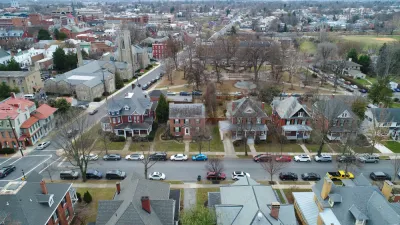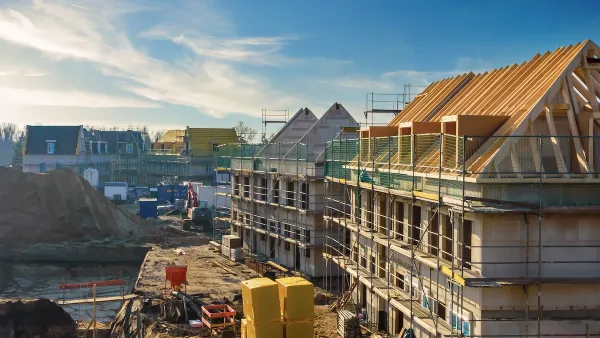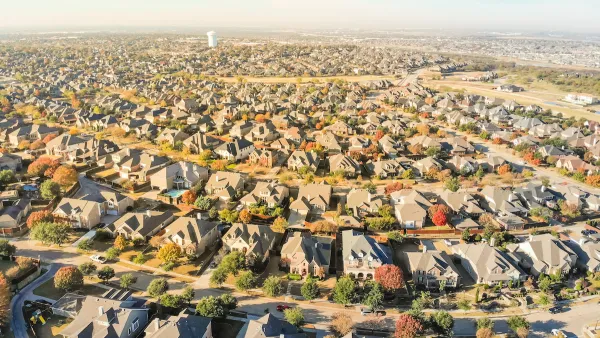Mapping housing production over the decades since the 1960s reveals a pattern that must be shifted to achieve the housing growth needed to face the economic and environmental challenges of the 21st century.

[Updated February 5, 2018] Issi Romem presents a series of maps and data findings on a study of housing growth at the census tract level in the country's largest metropolitan areas. The report Romem has created, titled "America’s New Metropolitan Landscape: Pockets Of Dense Construction In A Dormant Suburban Interior," shows exactly the huge swaths of the country that have completely stopped producing housing, and the few small places where housing growth is achieved.
Here's how Romem describes the subject of his inquiry:
In the past, virtually every patch of land in the metropolitan U.S. continually sprouted new housing, but this is no longer the case. In recent decades, residential construction has become increasingly confined to the periphery of American metro areas, while a growing swath of the interior has fallen dormant and produces new homes at a negligible pace. At the same time, a tiny fraction of the land area, scattered in small pockets throughout the metropolitan landscape, is responsible for a growing share of new home production, primarily in large multifamily structures. I refer to this increasingly spiky new pattern of housing production as “pockets of dense construction in a dormant suburban interior.”
To exemplify these concepts, Romem starts with a close study of the Los Angeles metropolitan area, telling the story above in maps, charts, and stylized diagrams. The stylized diagrams Romem has created segue to a point about how the pattern repeats in other metropolitan areas, like Atlanta, Dallas, Las Vegas, and Phoenix. Romem provides additional themes and concepts for understanding his findings, on subjects like how low-density development spreads and how the pickets of dense development are enabled under current land use regulation schemes.
All these findings and explanations lead to a big recommendation from Romen:
I am suggesting that, while cities continue to fight the battle for development in dense hubs, they also question the de facto exemption granted to low-density suburban areas from the onus to produce more housing. The dormant suburban sea is so vast that if the taboo on densification there were broken, even modest gradual redevelopment – tearing down one single-family home at a time and replacing it with a duplex or a small apartment building – could grow the housing stock immensely.
For more insight on Romem's findings, see an article written in admiration by Joe Cortright.
FULL STORY: America’s New Metropolitan Landscape: Pockets Of Dense Construction In A Dormant Suburban Interior

Analysis: Cybertruck Fatality Rate Far Exceeds That of Ford Pinto
The Tesla Cybertruck was recalled seven times last year.

National Parks Layoffs Will Cause Communities to Lose Billions
Thousands of essential park workers were laid off this week, just before the busy spring break season.

Retro-silient?: America’s First “Eco-burb,” The Woodlands Turns 50
A master-planned community north of Houston offers lessons on green infrastructure and resilient design, but falls short of its founder’s lofty affordability and walkability goals.

Test News Post 1
This is a summary

Analysis: Cybertruck Fatality Rate Far Exceeds That of Ford Pinto
The Tesla Cybertruck was recalled seven times last year.

Test News Headline 46
Test for the image on the front page.
Urban Design for Planners 1: Software Tools
This six-course series explores essential urban design concepts using open source software and equips planners with the tools they need to participate fully in the urban design process.
Planning for Universal Design
Learn the tools for implementing Universal Design in planning regulations.
EMC Planning Group, Inc.
Planetizen
Planetizen
Mpact (formerly Rail~Volution)
Great Falls Development Authority, Inc.
HUDs Office of Policy Development and Research
NYU Wagner Graduate School of Public Service




























